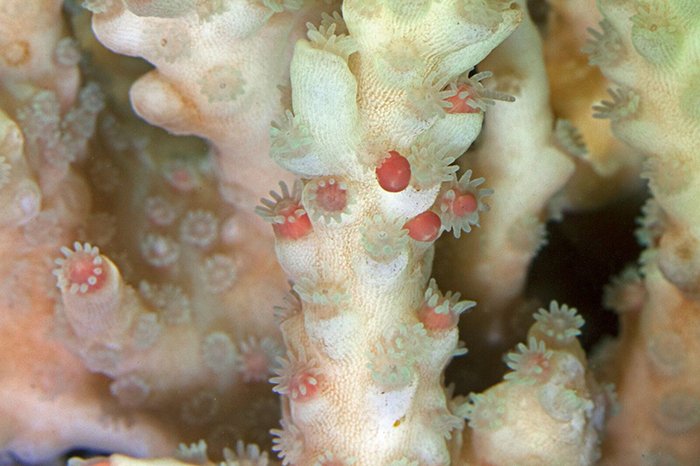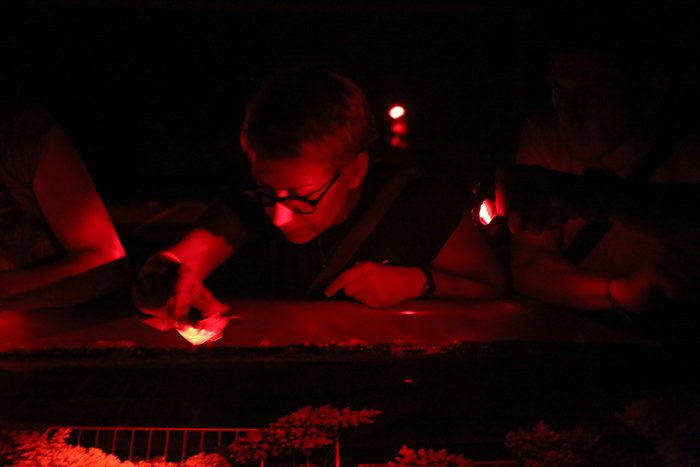Coral spawning: a rare natural wonder

EVERY YEAR, DIVERS AND snorkelers point their torches into the darkened waters of the Great Barrier Reef and Western Australia’s reefs, hoping to witness the annual ‘mass’ coral spawning event – where many colonies and species of coral polyps simultaneously release egg and sperm bundles for external fertilisation.
The spectacle resembles an underwater snowstorm, with a flurry of buoyant gametes, usually pink or white, slowly drifting upwards in a real-life version of a shaken snow dome.
Like heavy snowstorms, large-scale spawning is a mass of confusion and low visibility.
“If lots of coral colonies are spawning, trying to find which coral is releasing eggs becomes too difficult,” says Stuart Ireland, a marine biologist and underwater photographer. “But you can feel it. You run your fingers through (the water) and feel the eggs as they’re going up. It’s a little like if you’re driving slowly in the rain, and you put your head out the window and feel the little droplets on your face…it’s a strange feel.”
The largest event Stuart witnessed was in 1996, and he says one difference between that “intense” event and other’s he’s seen is “how much you smell of coral spawn” when you leave the water.
“The smell isn’t a bad one,” says Stuart, explaining it’s similar to the scent of coral mucus when the corals come out at low tide – just more pungent. “After the intense event, we actually had to use our regulators to blow holes through the (coral spawn) slick, it was so thick,” Stuart recalls.
Witnessing the coral spawning is a worthy addition to anyone’s bucket list – even if your hair does smell of coral spawn afterwards.
Footage from this year’s coral spawning on the Great Barrier Reef. (Credit: Stuart Ireland)
Coral spawning difficult to predict
While there are a few indicators for the initiation of these synchronised spawning events, predicting it is a tricky game. “You have to be in the right place at the right time,” says Stuart.
What is known is that the phenomenon only happens at night, after rising water temperatures have stimulated the maturation of gametes (the egg and sperm) within the polyps. And they usually occur over several days to just over a week after a full moon. It’s thought corals may be able to sense using primitive photoreceptors, although the time of year depends on location.
Thus far, the largest synchronised spawning events recorded have occurred on Queensland’s Great Barrier Reef and in Western Australia’s reefs. Large-scale spawning events on Western Australia’s reefs tend to occur in autumn, with smaller but significant events also recorded in spring, while large events on the Great Barrier Reef appear to take place only in late spring or early summer.
These factors can help experts identify probable spawning dates, and local operators schedule coral spawning trips based on expert advice. However, because the exact timing is still a bit of a mystery, operators can’t guarantee their clients will see the spawning.

A close-up view of coral spawning this week. (Image Credit: Philip Mercurio)
Coral spawning clues arrive late
Closely examining the coral during daylight hours on these dates doesn’t help experts, operators, or hopeful individuals pinpoint spawning nights either. This is because the coral doesn’t reveal definitive visible clues until after sunset, when the spawning is imminent.
“Usually about a half an hour to a couple hours before spawning, you can start to see the egg or sperm bundles starting to be formed underneath the polyp, and the tentacles tend to contract,” says Dr Peter Harrison, director of marine studies at Southern Cross University and a member of the research team at James Cook University who discovered the mass coral spawning phenomenon on the Great Barrier Reef in 1981.
“There’s no indication that ‘tonight’s going to be the mass spawning night’ until you’re actually underwater, in the dark, and start checking the corals,” he says.
Stuart agrees, saying he tends to see signs 20-30 minutes prior to spawning. “As the egg gets closer and closer to the mouth (of the polyp) then you can start to see more and more eggs. It’s a bit like a pimple developing, I suppose. You start to see it getting really close to
A video of coral spawning earlier this week. (Image Credit: AIMS)
Bleached corals making a recovery
Last month, a team of scientists surveying coral reefs located between Townsville and Cairns, which were devastated by two mass bleaching events between 2016 and 2017, found that large colonies of Acropora, an important reef building coral had produced several small white eggs, which scientists hope will grow into coral larvae.
While these early signs were encouraging, scientists have been eagerly awaiting this year’s spawning event, which they say will ultimately determine whether these corals have made a successful recovery.
Several corals colonies displaying eggs have been collected and given to scientists at the National Sea Simulator, a large research aquarium run by the Australian Institute of Marine Science (AIMS), dedicated to understanding how corals adapt to a changing environment.
The annual spawning event is just as important inside the aquarium as it is out on the reef.
“The preparation for the spawning event takes place months before hand. That consists of getting the tanks and the rooms ready. We know the corals we work on spawn after dark or just on dusk. That monitoring is based on decades of research,” AIMS coral biologist Line Bay told Australian Geographic.
“What we do is we isolate individual colonies and at spawning time they release their gametes into the water column. They’re buyoant so they float to the surface and we scoop them. Once we have the bundles we separate the egg and sperm and then we do fertislisation,” which can increase success rates.

Line Bay inside the National Sea Simulator (Image Credit: AIMS)
READ MORE:




